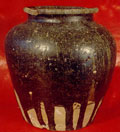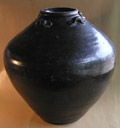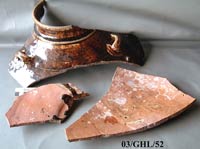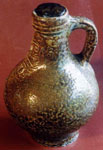 |
|
Maritime
Lanka
|
18 Dec 2004
|
|||
| Last modified: 18 Dec 2004 |
Products from the East were much sought after in Europe from the time of the first Portuguese voyages to Asia. Silks, lacquers, gilded objects and Chinese porcelain were all appreciated. However, the Portuguese made little effort to bring back such products, concentrating instead on the trade within Asia. When Dutch voyages to Asia started in the late 16th century, it became clear that luxury products from Asia for the European market could be hugely profitable. The establishment of the Dutch East India Company (VOC) in 1602 was the start of a multinational enterprise in goods from the East. During the course of the 17th century the Dutch also built up a profitable trade within Asia and the Middle East (Persia and Arabia).
As to the types of ceramics traded, we must distinguish the demands made by the Directors of the VOC in Holland from the demands of the Asian and Middle Eastern trading posts.
After the capture by the Dutch in 1602 and 1604 of two Portuguese 'carracks' with all kinds of products from the East, including Chinese porcelain, the Directors of the VOC also decided to order porcelain from China. Initially the return shipments to Holland contained porcelain 'of all types and qualities'(1). Later the directors started to give more specific orders as to shape and quantity. In popular demand were butter-dishes, plates, mustard-pots, wine jugs, bowls and cups in various shapes. The teacup with handle had not yet been 'invented', but tea from Japan was already being traded.
The amount of ceramics mentioned on invoices to Holland grew hugely during the 17th century, especially after the 1634 establishment of a VOC post on the island of Formosa enabling porcelain to be ordered directly from China. We see amounts of 100,000 to 250,000 pieces on the invoices of the return-ships(2). However, the trade from Formosa was stopped by 1662, due to turmoil in China, and thereafter porcelain shipments came mainly from Japan. After the reopening of the porcelain kilns in 1680 the ceramics trade came to be dominated by private traders and the VOC gradually became less involved. When European countries, including the Dutch, opened factories in Canton from 1727 for the tea trade, porcelain accounted for only 6% of the goods shipped to Holland(3).
Orders from Holland were primarily for good quality Chinese porcelain, whereas the ceramic trade within Asia consisted largely of sturdy provincially-made ceramics which sold well in all the VOC posts of Southeast Asia. This is known as 'Swatow' ware. It has been found on most of the VOC wrecks, for example the Mauritius (sunk in 1609), the Witte Leeuw (1613) and the Banda (1615).
Another important ceramic trade ware is the 'martaban'. The term 'martaban' has been used generally for strong storage jars. However, the term can be misleading, as it has also been associated specifically with jars made in the vicinity of Martaban, a port in Burma. In the VOC archives there are numerous references to this port. The first mention is as follows:
'In this city large earthenware pots are made, which are called martavanas in Indian; they are transported in large numbers through the whole of India; the reason that so many are transported is that in India they are used in houses and ships instead of jars: because there are none of such from Portugal; these come in their place to preserve oil, water and wine and such things, and it stays very well in them and it is a great comfort to the travelling man; because they also appear in Portugal; as they are used on ships from India, for water and oil etc.'(4)
These were locally made jars, which are still being produced, of unglazed high-fired earthenware. Stoneware jars from the Thai kilns were also transported overland to Martaban for export, or arrived there by ship.(5)
Around 1659, when the Avondster sank, most of the trade in ceramics and porcelain was concentrated between Japan and Formosa to Batavia and from there to Holland, with another flourishing trade between VOC posts in Asia. Galle was one of the most important VOC trade posts, but its role in the ceramics trade was mainly transhipment. Chinese porcelain arrived there via Formosa or Batavia, and was shipped mostly to Surat in India and to the Mocha and Gamron in the Middle East.(6) In 1643 for example:
'….it is reported from Ceylon that 300 pieces of porcelain have been taken over from one of the ships there and that the Waterhont had arrived at Pulicat from Formosa with 61,143 pieces of coarse porcelain and that the office at Masulipatam had shipped 23 cases of porcelain in native vessels for Persia and 229 cases of the same commodity in two sailings for Mocha.'(7)
So we see a lively transhipment of porcelain, but no orders for Sri Lanka itself except for one mention:
'On April 23rd [1645] the Governor of Ceylon had the rest of the cargo not in demand on the Malabar Coast, including some 1400 pieces of porcelain, taken from the Arent for the use of the garrison at Gale.'(8)
Such luxury items would surely only have been used by the officers.
Wealthy local people would also have used Chinese porcelain. Their preferences were different from those in Holland, and can be clearly seen in shards from Galle harbour and antiques in the local shops. Martabans were commonly traded, and these too can still be seen in Galle.
Interest in shipwreck ceramics has hitherto centred on wrecks with great numbers of ceramics sold at auction. The Avondster at the time of sinking was trading local products such as areca nuts, and ceramics were not an important part of the cargo. Therefore the number of shards is not very large, but the diversity is important, illustrating the ceramics carried on board during short voyages and for daily use.
The shards were sorted firstly according to material, then by shape, then by country of origin:
| A. Earthenware | B. Stoneware | C. Porcelain |
| A.1
Sri Lanka A.2 S.E. Asian A.3 European A.3.1 Dutch medicine jars A.3.2 Clay pipes |
B.1
Asian |
C.1
Chinese C.2 European |
As to their purpose, these can be categorised as follows:
Daily use on the ship:
- Galley: earthenware cauldrons/cooking pots - local
- Surgeon's chest: medicine jars
- Storage: storage jars (martavans)/ beardman jugs (wine/mercury)
- Cabin use: porcelain dishes and cups for mealsPersonal use/belongings:
- Chinese porcelain (probably bought as 'illegal' trade ware in Batavia where Chinese merchants brought their wares from China/Formosa)
- Clay pipes
Earthenware is made from local clay and fired at low temperatures of a maximum
of 800°C. There are numerous types of earthenware. 235 earthenware shards
were recorded, and classified according to the type of material and firing,
thickness, decoration and shape.
A.1 local earthenware from Sri Lanka
These are vessels made from local clays, moulded by hand or on a simple wheel, and fired in small village kilns. Traditions usually continue for generations, so that the shapes used today can be the same as 3-400 years ago. Nearly all the shards found belonged to some type of pot used for preparing, cooking or keeping food. Such pots would have been easily and cheaply bought in local markets.
One of the 'Dagregisters' of 1641 mentions the transport of pots: '371 pieces of earthenware pots were in Poeleceraa and Tegenepatnam to be taken from Battacaloa to St. Cruijs de Gale'.(9)
The shards are of two main types:
- Fine red fired: can be high fired; usually thin, fine body, unglazed
or glazed (transparent)
- Coarse red fired: many impurities, thick, can be unglazed or glazed
(transparent)
All earthenware shards from Galle harbour are of traditional utilitarian vessel forms, representing the local Plain Red Ware family (PRW/RW). The terms used in this description have been chosen basically from traditional and contemporary use in Sri Lanka. The vessels illustrated below can be traced to early periods, and there is much archaeological evidence of their long ancestry.(10)
Processing ware and storing ware
a) Cooking bowls:
i. Cooking bowls A (Sinhala: Äthili or äthiliya) - A wide-mouthed
shallow vessel with a rounded base. The mouth or orifice is wider than its belly.
The rim flattens outwards, with assorted rim variations. Multiple functions
in kitchen; especially used for cooking curries.
|
Figure 1. Äthiliya
and analogous form (on the right, 99/GHL/36c)
|
ii. Cooking bowls B (Sinhala: Hatti / Kundahatti) - A wide-mouthed shallow vessel. The mouth has almost the same size as the belly. The shape is quite similar to the äthili type, but shallower, and the base is not as flat. The body is squat and spherical. The rim flattens outwards. These bowls also have multiple functions, generally for boiling rice and yams but occasionally for cooking curries such as in the preparation of mällum (edible plant leaves).
Figure 2. Kundahattiya
and analogous form (on the right, 03/GHL/95)
|
b) Cooking pot:
i. Cooking pot (Sinhala: Häliya) - A squat rounded pot with an orifice,
smaller than the belly but wider than the 'muttiya'. This vessel is deeper than
kundahattiya. It has a flared rim with no neck, and the shoulder curves inwards.
These pots come in many sizes; small häliya are used for cooking rice (Sin.
bath-häliya: 'bath' means rice) and large häliya are used for
storage (Sin. pili-häliya, clothes-pot: 'pili' means clothes).
Figure 3. Häliya
and analogous form (on the right, 01/GHL/4)
|
ii. Cooking pot (Sinhala: Appalla) - the term used for large häliya. It has a flared rim with no neck and a sloping shoulder. The appalla is used for storing paddy or grains. When used for storage, it has a removable foot called Daranuva which is made of clay. This type of appalla is also used for cooking rice or curry for large ceremonial occasions.
Figure 4. Appalla and
analogous form (on the right, 99/GHL/36J)
|
iii. Cooking pot (Sinhala: Mutti) - There are two kinds of mutti: (a) carrinated bellied vessel, and (b) round-bellied vessel. The orifice is much smaller than the belly and that of the häliya. A mutti has an outward flaring rim, no neck, and sloping shoulders. There are three different sizes: large, medium and small. Large mutti are used for storage, eg of grains and foods. Medium-sized mutti are commonly used for cooking rice. Small ones are used for ritual purposes, for example when magical objects are buried in the ground for exorcist purposes. The Avondster has medium-sized mutti.
Figure 5. Muttiya and
analogous form (on the right, 99/GHL/36F)
|
c) Husking tray (Sinhala: Nämbiliya) - The orifice is wide with a thick rim. It has no shoulder.and the body is globular. Nämbiliya are among the most common vessels in domestic use today. They are used to sift sand and grit from the rice before boiling. The incised comb marks are characteristic.
Figure 6. Nämbiliya
and analogous form (on the right, 03/GHL/546)
|
Storing ware / Transferring ware:
a) Water container (Sinhala: Kale) - Narrowed orifice and globular body,
with a short neck. The Kale or Kalagediya is carried on the hip (especially
by rural women) while the neck of the kalagediya is held by the arm. There are
a few neck variations. This type is used for transporting and storing water
in most Sri Lankan homes.
b) Water pot B (Sinhala: Kotale) - A much smaller variation of kale.
The round orifice has a flared rim. The Kotala is a spouted vessel with a simple
neck which is used as a grip. Kotale were traditionally used for drinking water,
but are now used only for ritual purposes.
Figure 7. Kalagediya
and analogous form (on the right, 03/GHL/121)
|
A.2. Other Asian wares
Not all shards could be accurately identified as being locally made in Sri Lanka,
and as the ship went back and forth from India it is quite probable that pots
were bought there as well.
A.3 European earthenware:
A.3.1. Dutch medicine jars
These shards can be identified as being tin-glazed ware: coated with a mixture
of ground tin oxide diluted with water. When fired at a low temperature of about
800°C, this mixture turns into a white glassy surface. Sometimes the surface
is decorated with either cobalt, which turns to blue, or other metallic pigments.
There are many types of tin-glazed earthenware, but the Avondster finds
to date are the white and the white-with-blue types. The medicine jars will
be the subject of a separate paper.
A.3.2. Dutch clay pipes
These are common in all shipwrecks of Dutch origin, as pipes were used by the
crew. The clay pipes will be the subject of a separate paper.
Stoneware is fired at a temperature of 1000-1200°C. In order to sustain such a high temperature in the kiln, stoneware clay needs more minerals than earthenware clay; the most important are silica and aluminium. These minerals cause 'vitrification' so that the body of the vessel becomes non-porous. Kilns are usually found near deposits of suitable clay. Vessels are usually shaped on a wheel, and glazed on the outside and sometimes on the inside.
There are two identifiable types of stoneware among the Avondster shards: storage jars from Asia (martabans), and beardman jugs from Europe.
B.1 Stoneware storage jars from Asia (martabans)

 B.1.1 Chinese stoneware storage jars
B.1.1 Chinese stoneware storage jars
Characteristics are a pale beige or yellow stoneware body covered in a dark-brown
glaze which stops short of the base. The neck is short, and the mouth not very
wide with a short rolled lip. Usually four small horizontal handles rest on
the shoulder. Earthenware lids could be placed on the mouth and tied down with
string using these 'handles'. These jars were produced for hundreds of years
in South China and commonly traded over maritime routes. They were not only
used for food and water but also as containers for goods, even porcelain. When
filled with alcohol they bore a seal stamp near the mouth; they are still used
for this purpose today.
 B.1.2 Thai stoneware storage jars
B.1.2 Thai stoneware storage jars
Characteristics are a hard stoneware body in many different colours - usually
dark grey, black, purple or mixed (because of different clay types and firing).
Most are covered with a glossy dark-brown/black glaze; sometimes drips can be
seen on the lower half where it is unglazed. The neck is high and the mouth
flared with a pronounced rolled lip. Again 4 handles are positioned on the shoulder
of the jar to tie down a cover. These jars were made at Maenam Noi, in the Bang
Rachan area of Singburi province in Thailand.(11)
There was an enormous market for these storage jars throughout
Asia. In the Kota Batu excavation in Brunei they accounted for more than 60%
of jars found(12),
and they are commonly found on the numerous shipwrecks of Southeast Asia.
B.1.3 Other Asian stoneware
Not all the stoneware shards have been fully identified; only a few will have
come from other SE Asian countries.
B.2 Stoneware jars from Europe (beardman jugs)
B.2.1.German beardman jugs (also known as Bellarmines)

 These
characteristic jars, more accurately called jugs as they all have a narrow neck,
originate from the Rhine area in Germany. The body is of white, buff or grey
clay with a rich content of silica acid which vitrifies at a high temperature.
For this reason a lead glaze could not be applied. Instead common salt was thrown
into the kiln during firing and the soda formed during this process combined
with the silica and alumina in the body leaving a thin, colourless glassy film
on the surface. Colour is added by thin washes of slip stained brown by iron
(usually), blue by cobalt, or purple by manganese. Beardman
jugs from the Avondster site: most of the pieces were found in or
near the galley, and would have been used for storing special liquids such as
oils or alcohol. They were a common part of a Dutch ship's inventory, as can
be seen by the numbers found on VOC shipwrecks such as the Batavia, Vergulde
Draak, and Witte Leeuw.
These
characteristic jars, more accurately called jugs as they all have a narrow neck,
originate from the Rhine area in Germany. The body is of white, buff or grey
clay with a rich content of silica acid which vitrifies at a high temperature.
For this reason a lead glaze could not be applied. Instead common salt was thrown
into the kiln during firing and the soda formed during this process combined
with the silica and alumina in the body leaving a thin, colourless glassy film
on the surface. Colour is added by thin washes of slip stained brown by iron
(usually), blue by cobalt, or purple by manganese. Beardman
jugs from the Avondster site: most of the pieces were found in or
near the galley, and would have been used for storing special liquids such as
oils or alcohol. They were a common part of a Dutch ship's inventory, as can
be seen by the numbers found on VOC shipwrecks such as the Batavia, Vergulde
Draak, and Witte Leeuw.
C.1 Chinese porcelain
The few pieces of porcelain from the Avondster site are clearly personal
belongings, as they are individual pieces and not 'sets' such as dinner services.
Most shards belong to small teacups and simple bowls. Only a few shards of plates
have been found. The following categories are represented:
(a) Coarse porcelain from kilns in the Swatow area of South China (bowls
of various sizes);
(b) Porcelain from provincial kilns, also in South China (bowls and shallow
plates);
(c) Fine porcelain from Jingdezhen (tea bowls).
Notable finds include shards of plates of 'kraak' type and design corresponding exactly to dishes salvaged from the 'Hatcher junk' sunk in 1643-46.(13) The shard on the right comes from a pot design associated with the period 1610-1620 and no later. These were a Portuguese favourite: many can be seen in Lisbon museums, and they are imitated in Portuguese faience.(14)
An even more remarkable find is a spout and part of the neck of a small ewer which is identical to one found on the Witte Leeuw sunk in 1613, forty-six years before the wrecking of the Avondster. Another shard belongs to a covered box identical to one from the Witte Leeuw. At the time of the Avondster's sinking, these designs were probably no longer in production. They may have been in use for some time, passed down as heirlooms, or bought as antiques.
The Avondster finds have illuminated the types of ceramics used in everyday life on a ship of this period. There are vessels used for daily consumption or storage, and some high quality pieces of Chinese porcelain which were either used personally or kept as 'souvenirs' or 'antiques'. There are ceramics of differing quality, just as there were people of various classes on board. Cooks and sailors were unlikely to own fine Chinese porcelain, but might have owned coarse-ware porcelain bowls. Officers would have been able to buy special pieces during their voyages to Batavia or other parts of Asia. The ceramics illustrate the historical network of contacts between Galle and the rest of Asia.
This webpage is adapted from 'The ceramic finds from the Avondster', by Christine van der Pijl Ketel, Ranjith & Nayana Bandara, to be included in the Avondster Project Report 2003-2004. See that report for full bibliography.
| Maritime Lanka homepage | Beardman jugs on the Avondster |